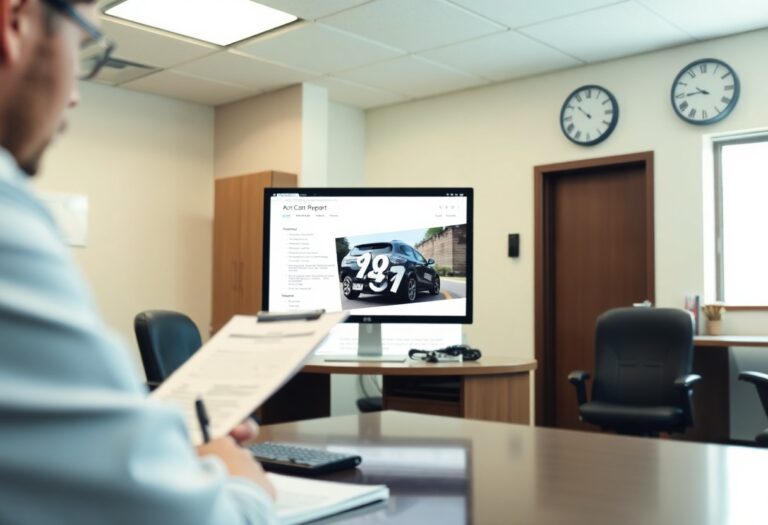Most drivers in Franklin County will encounter situations that require obtaining a crash report after an accident. This guide offers you clear steps to efficiently navigate the process, ensuring you have the necessary documentation for insurance claims or legal proceedings. Understanding how to retrieve your report will help you save time and reduce stress during a challenging period. Let’s walk through the crucial procedures and resources available to you in Franklin County.
Navigating the Law: Understanding Franklin County’s Reporting Requirements
In Franklin County, every driver involved in a crash must adhere to specific reporting obligations. Pennsylvania law mandates that accidents resulting in injury, death, or significant property damage be reported to the police. Additionally, you are required to provide a written report to the Pennsylvania Department of Transportation (PennDOT) within 5 to 10 days, depending on the incident severity. Understanding these requirements helps to navigate the aftermath more effectively and ensures compliance.
The Legal Framework for Crash Reporting
The state of Pennsylvania sets forth a framework within Title 75 of the Pennsylvania Consolidated Statutes for crash reporting. This includes defining the types of accidents that necessitate a report, as well as the timelines and specific forms to be utilized. Familiarizing yourself with these laws protects you from potential legal repercussions and ensures that your report is valid and timely.
Who Has Access to Generated Reports?
Accessibility to crash reports in Franklin County is limited to certain individuals and entities. Generally, parties involved in the accident, their insurance companies, and legal representatives have the right to access these documents. However, law enforcement agencies, along with specific government organizations, can also retrieve reports to assess traffic incidents and enhance public safety measures.
Access to crash reports is strictly regulated to protect the privacy of those involved in the incidents. For instance, if you’re a driver in a crash, you can obtain your report directly from the police or the department that compiled it. Insurance companies often seek these reports to determine claims and payouts, while legal representatives might request them during litigation proceedings. However, third parties without direct involvement typically cannot access these reports, ensuring the confidentiality of sensitive information.
First Steps: Initiating Your Request for a Crash Report
After understanding the reporting requirements, you can now take the first steps toward obtaining your crash report. The process begins by determining whether you are eligible to request a report, which typically includes being a participant in the incident, a representative of a participant, or someone with a legitimate interest in the record. Knowing your standing helps clarify your best path forward.
Gathering Necessary Information
A successful request hinges on gathering all imperative details pertaining to the incident. This includes the date, time, and location of the crash, as well as the names and addresses of those involved. If you obtained a report number at the scene, make sure to have it handy as this can expedite the retrieval process.
Choosing the Right Channel for Your Request
Selecting the appropriate method for submitting your crash report request can dramatically affect the speed and ease of the process. Options typically include online submission, in-person visits to the local police station, or mail requests. Each method has its own advantages, so understanding them helps streamline your retrieval experience.
Online submission is often the most convenient option, allowing you to fill out forms and submit your request from your home or office. Franklin County’s police department frequently provides digital access to the resources necessary for this process, often resulting in faster turnaround times compared to mailing in a request. In-person visits, while requiring more effort, could provide opportunities to resolve any immediate questions with a police clerk, facilitating a smooth retrieval of your report.
The Retrieval Process: What to Expect
Retrieving your crash report in Franklin County can be a straightforward process if you are prepared. You will typically need to visit the appropriate department, such as the local police department or the Pennsylvania Department of Transportation. Be sure to provide your identification and details of the accident, including date, location, and involved parties. Most times, staff members will guide you through the steps for acquiring your report smoothly, but having your documentation ready will make the experience more efficient.
Timeframes and Processing Fees
Expect to wait anywhere from a few days to several weeks for your crash report to be processed. Different agencies have varying timeframes, often influenced by their workload. In terms of fees, accessing reports typically incurs a nominal charge, often around $15, although this may vary depending on the jurisdiction and the specific details of your request.
Potential Challenges in Report Access
At times, accessing your crash report might not be as simple as anticipated. Challenges can include missing information, delays in processing, or reports that are not yet available due to ongoing investigations. Depending on the nature of the incident, certain reports may also be restricted from public access, complicating your retrieval process.
Usually, issues arise when the accident involves serious injuries or fatalities, as these reports may be restricted while investigations are conducted. If you’re facing hurdles, don’t hesitate to contact the relevant department for clarification on the status of your report. Occasionally, establishing an online portal for access can streamline the process or allow you to check the report’s progress without multiple visits to the office. Be persistent and patient, as these challenges are not uncommon.
Beyond Retrieval: Utilizing the Information Effectively
Once you have your crash report, leveraging the information effectively plays a critical role in your follow-up actions. The details within the report provide a comprehensive view of the incident, including factors that impacted the accident. You can use this information to navigate the claims process, negotiate with insurance companies, and even prepare for possible legal actions, all while ensuring that your case is built on solid, factual foundations.
Understanding the Contents of Your Crash Report
Your crash report includes vital data such as the date, time, and location of the incident, a summary of the events leading up to the crash, and eyewitness accounts. Key details regarding the involved vehicles and individuals, along with any citations issued, are also included. By thoroughly reviewing these elements, you can gain a clearer understanding of the circumstances surrounding the crash and the liability involved.
The Importance of Accurate Documentation for Claims
Accurate documentation directly influences the outcome of your insurance claims. Insurance adjusters rely heavily on the details of the crash report to assess fault and determine compensation. A well-documented report can expedite the claims process, while discrepancies or inaccuracies may lead to disputes or claim denials. When you present your documentation clearly, it strengthens your position and supports your case in negotiations.
For example, if your report clearly outlines the other party’s negligence, you can reference this information in discussions with the insurance company to substantiate your claim. On the other hand, if there are errors, such as incorrect vehicle details or misidentified parties, these can create obstacles in processing your claim. Therefore, ensuring accuracy in your crash report is not just a formality; it’s a strategic step that can significantly impact your financial recovery and overall peace of mind.
Personal Safety and Prevention: Lessons from Local Data
Understanding traffic-related incidents in Franklin County helps enhance personal safety and reduce accidents. Local data reveals that nighttime driving significantly increases the likelihood of collisions, with a staggering 40% of crashes occurring after dark. By learning from these statistics, you can take proactive measures, such as avoiding late-night drives or using alternative transportation options, to minimize your risk on the road.
Analyzing Traffic Trends in Franklin County
Recent analysis of traffic trends shows notable patterns, particularly concerning high-traffic areas and peak accident times. Major thoroughfares, including Route 30 and Interstate 81, tend to see increased incidents during commuter rush hours, between 7 AM and 9 AM and 4 PM to 6 PM. Recognizing these trends allows you to better plan your travel schedule and choose safer routes.
How to Stay Informed and Prepared
Staying informed about local traffic conditions can significantly improve your driving experience. Utilize online resources such as traffic apps or local news websites, which provide real-time updates on road conditions, construction, and any reported accidents in Franklin County. Additionally, consider following local law enforcement on social media for alerts and tips on safe driving practices.
Leveraging technological tools can help you stay ahead of potential hazards. By subscribing to traffic alerts or using navigation apps with live updates, you can receive notifications about accidents, road closures, or adverse weather conditions. Engaging with community resources, such as safety workshops, can further equip you with practical knowledge to reduce risk. Knowledge and preparation are key to ensuring your safety and that of others on the road.
To wrap up
Ultimately, navigating the process of crash report retrieval in Franklin County, Pennsylvania can be straightforward with the right guidance. By understanding the necessary steps and resources available to you, such as local law enforcement or online platforms, you can efficiently obtain your report. Taking advantage of these resources not only aids in your recovery from an accident but also empowers you in any subsequent legal or insurance matters. Your proactive approach can make a significant difference in how you manage the aftermath of a crash.













